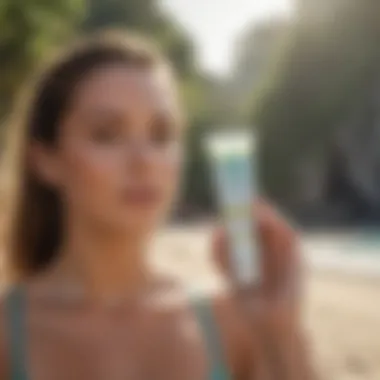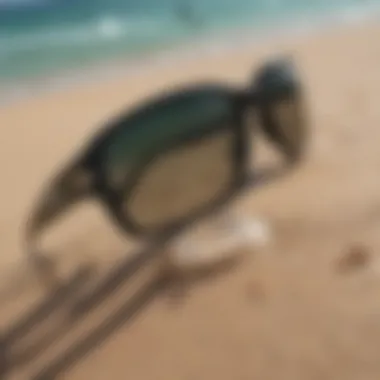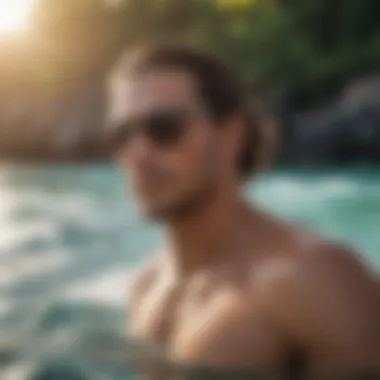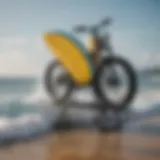Exploring Tropicsport Sunscreen for Watersports


Intro
In the world of water sports, sun protection is essential. This comprehensive guide aims to provide watersports enthusiasts with detailed insights into Tropicsport Sunscreen. Understanding its formulation and effectiveness can greatly enhance the enjoyment of activities like surfing, sailing, snorkeling, and paddleboarding. Knowing how to apply sunscreen effectively is crucial for protecting skin from harmful UV rays. This article will delve into the key ingredients, user experiences, and practical application tips that can ensure optimal protection.
Water Activity Overview
Water activities expose participants to extended sun exposure. Therefore, effective sun protection is vital. Each activity has unique conditions that can impact sunscreen performance.
Surfing
Surfing often occurs during peak sunlight hours. Riders frequently face direct sun on water, making a high SPF sunscreen necessary. Look for options that are both water-resistant and specifically formulated for ocean exposure.
Sailing
Sailing can expose participants to UV rays reflected off the water. A broad-spectrum sunscreen with at least SPF 30 is recommended. Reapplication is key when spending long hours on a boat, especially during smooth sails with minimal shade.
Snorkeling
Snorkelers must consider both the sun above and potential coral below. Biodegradable sunscreens are advisable to protect marine life. Prioritize products that do not harm ocean ecosystems while providing adequate coverage.
Paddleboarding
While paddleboarding, enthusiasts are often in full sun. A high-water-resistant formula can provide reliable protection during activities involving splashing and extended periods on the water. Applying sunscreen before hitting the water will ensure a solid start to your session.
Tips and Techniques
Protection from sunburn is critical; therefore, mastering proper application techniques is important.
Tips for Beginners
- Start with a water-resistant sunscreen.
- Apply generously and evenly.
- Reapply every two hours, or after swimming or sweating.
- Avoid tanning oils, as they do not provide adequate protection.
Advanced techniques for experienced enthusiasts
- Layer different types of sunscreen for enhanced protection.
- Use a sunscreen stick for hard-to-reach areas like the back of the neck.
- Consider UV protection clothing as an additional layer of safety.
Safety guidelines
- Always check the expiration date of sunscreen.
- Conduct patch tests for potential allergic reactions.
- Be aware of local regulations regarding sunscreen use in sensitive marine environments.
Gear Reviews
The right gear is essential for an enjoyable experience in water sports. Here is an overview of essential equipment.
Surfboards
Look for boards made from durable materials suitable for various wave conditions. Choose designs that cater to your skill level, whether you are a beginner or an expert.
Sailboats
Invest in a sturdy sailboat built for reliability in different wind conditions. Consider features like comfort and storage for long trips.
Snorkeling equipment
Choose masks that fit well. Fins should enhance your kicking power without causing discomfort.
Paddleboards
Opt for boards designed for your intended use, whether leisure or racing. Stability and buoyancy are important for all skill levels.
Wetsuits
Select a wetsuit based on water temperature. The thickness and fit significantly affect comfort and warmth while participating in aquatic activities.
Destination Guides
Exploring various locations can enhance the watersports experience. Here are some noted destinations:
Popular water sports locations
- Hawaii is renowned for surfing.
- Florida’s coast is ideal for sailing.
- The Great Barrier Reef offers exceptional snorkeling experiences.
Hidden gems for water enthusiasts
- The Azores provide beautiful spots for paddleboarding.
- Bonaire is less crowded, making it great for snorkeling.


Travel tips for water sports trips
- Research local weather conditions before your visit.
- Always check for nearby facilities and safety features.
"Protection against UV rays is not just a personal choice, but a responsibility towards maintaining a healthy environment."
A well-rounded understanding of Tropicsport Sunscreen can significantly enhance your water sports practice. This guide aims to empower users with the necessary knowledge to protect themselves from the sun while enjoying their favorite aquatic activities.
Prelude to Tropicsport Sunscreen
Understanding the importance of sun protection is critical for anyone spending time outdoors, especially for watersports enthusiasts. Sun exposure risks include skin damage, premature aging, and even skin cancer. Hence, using a quality sunscreen like Tropicsport is vital in these circumstances.
Tropicsport Sunscreen is notable for its unique formulation, specifically designed to withstand the rigors associated with various water activities. This article delves into why Tropicsport stands out in the crowded sunscreen market while also emphasizing essential factors in sun protection.
Overview of Sunscreen Importance
Sunscreens help protect the skin from harmful ultraviolet (UV) rays emitted by the sun. These rays can cause immediate effects like sunburn and long-term effects, including the risk of skin cancers. Different types of sunscreen formulations exist, each serving the important function of shield the skin from the sun's harmful effects.
Ultimately, choosing the right sunscreen is not just about preference but about effective protection. For watersports enthusiasts, characteristics like water resistance and broad-spectrum coverage become essential. Using sunscreen that meets these demands can significantly reduce the risk of UV exposure.
Why Choose Tropicsport?
Tropicsport Sunscreen is an excellent choice for those who partake in water-based activities. This brand is often recommended due to its commitment to providing effective sun protection while also considering the needs of its users.
One major advantage is its formulation, which often includes ingredients like zinc oxide. This is a physical sunblock which reflects UV rays away from the skin, providing a strong protective barrier. Moreover, Tropicsport distinguishes itself by offering products that are both water-resistant and reef-safe. These features matter when choosing a sunscreen, especially when eco-friendliness is part of the equation.
In summary, Tropicsport Sunscreen emerges as a favorable option for those heavily engaged in watersports due to its focus on durability, performance, and environmental responsibility.
Understanding Sunscreen Formulations
Understanding the different formulations of sunscreen is essential for anyone engaging in outdoor activities, particularly watersports. Sunscreens serve as a critical barrier between harmful ultraviolet (UV) rays and our skin. Each formulation offers distinct benefits and drawbacks, influencing both effectiveness and user experience. It is imperative to select the appropriate type based on individual skin needs, activity levels, and environmental factors. This section will delineate the two primary categories of sunscreens and clarify how SPF ratings work in assessing their protective quality.
Physical vs. Chemical Sunscreens
Sunscreens can generally be divided into two main categories: physical and chemical.
Physical sunscreens, often referred to as mineral sunscreens, typically contain active ingredients like zinc oxide and titanium dioxide. These ingredients work by forming a physical barrier on the skin that reflects harmful UV rays away from the body. This formulation is often recommended for those with sensitive skin, as it tends to cause fewer skin irritations. Furthermore, physical sunscreens are often thicker, offering a more consistent application over the skin surface.
On the other hand, chemical sunscreens absorb UV rays through chemical reactions. Ingredients such as avobenzone, octisalate, and octocrylene are commonly found in these products. While they may offer the advantage of a lighter feel and easier application, they may not provide immediate protection as they typically require about 20 minutes to absorb into the skin before efficacy begins. Some users, especially those with sensitive skin, might experience reactions or irritations with chemical formulations.
SPF Ratings Explained
SPF, or Sun Protection Factor, is a critical measurement that indicates the level of protection a sunscreen offers against UVB rays, which are primarily responsible for sunburn. A higher SPF value suggests a higher level of protection.
- For instance, an SPF of 30 blocks approximately 97% of UVB rays, while an SPF of 50 blocks about 98%. This slight increase in percentage is often misunderstood as significantly more effective protection.
It's essential to understand that no sunscreen can offer 100% protection. Factors like skin type, water exposure, and physical activity levels can influence the actual efficacy of sunscreen usage.
"SPF does not reflect the duration of sun exposure. Always reapply sunscreen at regular intervals, especially after swimming or sweating."
In summary, recognizing the differences between physical and chemical sunscreens, as well as understanding SPF ratings, allows watersports enthusiasts to make informed choices about their sun protection. Opting for the right formulation and using it correctly ensures optimal protection against damaging UV rays during outdoor activities.
Key Ingredients in Tropicsport Sunscreen
The effectiveness of any sunscreen greatly depends on its key ingredients. For watersports enthusiasts, understanding these components is essential. Tropicsport Sunscreen has formulations that cater to various needs, making the choice of ingredients vital for effective sun protection.
Zinc Oxide and Titanium Dioxide
Zinc oxide and titanium dioxide are the primary active ingredients in Tropicsport Sunscreens. Both are classified as physical (or mineral) sunscreens. They function by sitting on the skin's surface and effectively blocking harmful UV rays before they penetrate the skin. This approach is essential for individuals involved in watersports, where prolonged sun exposure occurs.
Benefits of Zinc Oxide and Titanium Dioxide:
- Broad-spectrum protection: They provide protection against both UVA and UVB rays, which is crucial since both types can cause skin damage.
- Gentle on the skin: These ingredients are less likely to irritate sensitive skin compared to certain chemical sunscreens. This aspect is vital for those who may spend hours in the water or under the sun.
- Water resistance: The physical nature allows them to remain effective even when wet, which aligns with the needs of watersports participants.
Aloe Vera and Other Moisturizers
Aloe vera and other moisturizing ingredients play a significant role in Tropicsport's formulation. The presence of aloe vera is particularly interesting due to its well-documented soothing properties.
Benefits of Aloe Vera and Moisturizers:
- Hydration: Sunscreen should not only protect but also maintain skin hydration. Aloe vera helps to prevent dryness, which can occur after long sun exposure.
- Healing properties: The anti-inflammatory properties of aloe can assist in healing any skin irritation caused by sun exposure.
- Complementing the physical blockers: Moisturizers in Sunscreens, like aloe, can help the application feel smoother and more pleasant, encouraging users to apply adequate amounts.
"The right ingredients are not just a choice; they significantly influence the overall effectiveness of sun protection, especially for those who are often in water environments."
Overall, the key ingredients found in Tropicsport Sunscreen are thoughtfully chosen to offer comprehensive protection while also ensuring user comfort and skin health. Choosing a sunscreen with effective ingredients is essential for anyone who enjoys spending time in water.
Effectiveness of Tropicsport Sunscreen


The effectiveness of any sunscreen is crucial for watersports enthusiasts. Given the unique conditions faced during aquatic activities, such as prolonged sun exposure and frequent water immersion, understanding how well Tropicsport Sunscreen performs can significantly influence your choice. The two main factors to consider are water resistance duration and broad-spectrum protection, which protect the skin from harmful UV rays.
Water Resistance Duration
Water resistance is a key feature for any sunscreen designed for water activities. Tropicsport Sunscreen claims a water resistance duration of up to 80 minutes, which is essential for anyone engaging in swimming, surfing, or other water sports. This means that after applying the sunscreen, users can be more confident in its ability to remain effective during vigorous activity in the water.
When testing sunscreens, it is recommended to follow a few guidelines:
- Apply generously, ensuring full coverage on all areas of the skin.
- Wait at least 15 minutes before entering the water for optimal absorption.
- Reapply after prolonged water exposure or excessive towel drying.
Considering the rapid production of sweat or water displacement, the mentioned application techniques help in retaining the effectiveness of the sunscreen. Proper application enhances the protective qualities, ensuring users remain shielded against potential sun damage for the duration of those key 80 minutes.
Broad-Spectrum Protection
Broad-spectrum protection refers to a sunscreen's ability to block both UVA and UVB rays. Tropicsport Sunscreen emphasizes its broad-spectrum formulation, making it suitable for individuals exposed to the sun for extended periods. UVA rays can prematurely age skin, while UVB rays cause sunburn, both posing risks that serious watersports enthusiasts should be aware of.
The SPF rating of Tropicsport Sunscreen is an indicator of its effectiveness. Higher SPF numbers provide more protection; however, proper application and regular reapplication are equally important to maintain a barrier against the sun’s harmful rays.
To summarize:
- Broad-spectrum protection safeguards the skin from various types of UV radiation.
- Following the application guidelines ensures that the sunscreen remains effective.
"Choosing a sunscreen with high SPF and broad-spectrum protection is crucial, especially for those who spend a lot of time on the water."
Application Techniques for Optimal Results
Applying sunscreen correctly is crucial for effective protection against harmful UV rays, especially for watersports enthusiasts. Using Tropicsport Sunscreen effectively not only enhances its protective abilities but also ensures a comfortable experience during water activities. This section covers essential techniques that optimize the use of Tropicsport Sunscreen, along with key benefits and considerations.
How to Apply Sunscreen Correctly
To achieve optimal sun protection with Tropicsport Sunscreen, it is important to follow these steps for proper application:
- Start with Clean Skin: Make sure your skin is clean and dry before application. This helps the sunscreen adhere better.
- Generous Amount: Use a sufficient amount of sunscreen. Common recommendation is about one ounce or a shot glass full for full-body coverage.
- Even Coverage: Spread the sunscreen evenly across all exposed skin. Pay attention to areas like the back of the neck, ears, and the tops of feet.
- Timing: Apply the sunscreen 15 to 30 minutes before sun exposure. This allows the ingredients to bind properly with the skin and offer the best protection.
- Rub In Thoroughly: Ensure you rub it in thoroughly for even protection. Avoid missing spots, as this can lead to sunburn.
- Avoid Friction With Water: If you plan to go in the water, remember that water can wash away the sunscreen. Using the water-resistant formula of Tropicsport helps maintain its effectiveness.
Reapplication Guidelines
To maintain effective sun protection while engaging in watersports, reapplication of Tropicsport Sunscreen is essential. Here are key guidelines for reapplication:
- Frequency: Reapply at least every two hours. If you are swimming or sweating, additional applications may be needed more often.
- Post-Water Exposure: After swimming or towel drying, reapply immediately to ensure full protection. Even water-resistant sunscreens can lose effectiveness when exposed to water.
- Areas to Focus On: Pay special attention to areas that may be easily missed or that see more friction, like around the collarbone, your knees, and your feet.
Keeping these techniques in mind will maximize the effectiveness of Tropicsport Sunscreen, allowing you to enjoy your time in the water without worrying about UV damage.
Implementing these simple application techniques can significantly reduce the risk of sunburn. Proper application and timely reapplication of sunscreen help create a protective barrier against harmful UV rays, ensuring you remain safe while enjoying your aquatic activities.
User Experiences and Reviews
User experiences are crucial in understanding the true effectiveness and acceptance of Tropicsport Sunscreen among watersports enthusiasts. Personal testimonials provide insights that go beyond marketing claims, offering valuable perspectives from real users facing similar conditions. Reviews enable prospective buyers to gauge the practical aspects of the sunscreen, including ease of application, texture, and real-world performance during various water activities.
By examining these experiences, potential users can discern how well the sunscreen adheres to its promises of protection and comfort. Furthermore, these narratives often highlight the scenario of repeated exposure to sun and water, which is vital to evaluating any sunscreen's reliability and endurance.
Positive Feedback from Watersports Enthusiasts
Many watersport enthusiasts have expressed satisfaction with Tropicsport Sunscreen, highlighting its water-resistant properties and smooth application. Users appreciate how easy it is to spread over the skin and that it doesn’t leave a greasy residue, which is often a common issue with other products. The lightweight formula contributes to comfort during intense activities like surfing or kayaking.
Users frequently mention the effectiveness in preventing sunburns even after hours spent in direct sunlight. Reports of prolonged wear without needing immediate reapplication serve as a testament to its robust formulation.
"After using Tropicsport Sunscreen for a season, I can confidently say it's reliable. I didn’t get burnt, and even after hours in the ocean, it stays put."
Addressing Common Concerns
Despite the positive feedback, there are some concerns that users have raised regarding Tropicsport Sunscreen. One common apprehension is the amount of product required for adequate coverage. Some users have found that they need to apply a generous amount to achieve desired protection levels, leading to worries about quick depletion of the bottle.
Another concern involves the sunscreen’s scent. While many appreciate its mild fragrance, others find it too strong or overpowering during prolonged use. Additionally, varying skin types may react differently, with some individuals reporting breakouts from the product, leading to the importance of patch testing.
Balancing these experiences helps future users set realistic expectations. Addressing such concerns fosters an environment where potential buyers can make more informed decisions about whether this product fits their needs.
Comparative Analysis with Other Brands
A comparative analysis of Tropicsport Sunscreen with other brands is crucial for watersports enthusiasts who wish to make informed decisions. Understanding how Tropicsport stacks up against competitors allows users to evaluate their options based on performance, formulation, and user satisfaction. In this segment, we will identify the key factors that make such comparisons beneficial.
- Performance Metrics: Evaluating the effectiveness of different sunscreens under similar conditions helps consumers identify which products offer the best protection during their water activities. This includes examining aspects such as SPF ratings, water resistance, and broad-spectrum capabilities.
- Ingredient Transparency: Analyzing the formulations of Tropicsport alongside other brands can highlight differences in ingredient quality and sourcing practices. This is increasingly important as consumers become more aware of what they apply to their skin, particularly for products used during outdoor activities.
- User Reviews and Experiences: Comparing testimonials and ratings from actual users can expose strengths and weaknesses of each brand. This information proves invaluable as it reflects real-world performance over metrics alone.
Tropicsport vs. Competitors
When comparing Tropicsport Sunscreen to leading competitors, several elements come into play. Brands like Neutrogena, Coppertone, and Banana Boat also cater to the watersports market. Each of these brands delivers varying degrees of effectiveness and customer satisfaction.


- SPF Options: Tropicsport Suncreen offers a range of SPF levels, comparable to that of Neutrogena. Users often find Tropicsport effective for prolonged exposure to strong sunlight.
- Water Resistance: In terms of water resistance, Tropicsport holds up well against Coppertone and Banana Boat, both of which claim long-lasting protection. Consumers report similar experiences with all three brands.
- Skin Compatibility: Some users favor Tropicsport for its minimalistic formulation, especially those with sensitive skin. This is a significant advantage over competitors that often include more synthetic ingredients.
Cost versus Performance
Price remains a vital factor for many consumers when choosing sunscreen. Evaluating cost versus performance helps enthusiasts determine whether they are receiving good value for their investment.
- Price Range: Tropicsport products generally fall into the mid-range category when compared to premium brands like La Roche-Posay. This can be appealing to users looking for effectiveness without a steep price tag.
- Performance Justification: Many users argue that the higher cost of premium brands does not always translate to better performance. Reviews often demonstrate that Tropicsport's effectiveness justifies its price, especially for those engaged in intensive watersports.
"Understanding the balance between cost and performance is essential for ensuring you get the best protection without overspending."
- Overall Value: When considering factors like effectiveness, ease of application, and user satisfaction, Tropicsport often emerges as a favorable option. Users frequently highlight that it meets their needs without the higher price point typically associated with competitors.
Environmental Considerations
The selection of sunscreen extends well beyond personal protection. For watersports enthusiasts, environmental considerations are increasingly vital. Sunscreens contain chemical ingredients that might harm the marine ecosystem. Consumers must recognize these impacts when choosing their products. Protecting coral reefs and aquatic life is essential, especially in popular water activity locations.
Coral Reef Friendly Formulation
One prominent aspect of Tropicsport Sunscreen is its coral reef friendly formulation. This attribute reflects a commitment to safeguarding delicate marine environments. Traditional sunscreens often feature harmful chemicals like oxybenzone and octinoxate, which can lead to coral bleaching. In contrast, Tropicsport uses non-toxic ingredients that do not compromise coral health.
Research indicates that even small amounts of these chemicals can disrupt marine biology, affecting not only the coral itself but also the entire ecosystem dependent on it. By choosing Tropicsport, users contribute to the preservation of our oceans.
"Wearing sunscreen should not come at the expense of marine ecosystems. Choosing reef-safe options is a step toward responsible water sports."
Sustainability Practices in Production
Tropicsport is also dedicated to sustainability practices in production. The brand recognizes that environmental impact extends beyond the product's application. By embracing eco-friendly manufacturing processes, the brand minimizes its carbon footprint. This includes using renewable energy sources and sustainable materials in their packaging.
Moreover, Tropicsport actively engages in initiatives aimed at reducing plastic waste. This commitment resonates well with environmentally-conscious consumers, particularly those involved in outdoor activities. As users make informed choices, the cumulative effect can significantly benefit our planet.
In summary, selecting a sunscreen like Tropicsport is not just about individual sun protection. It is also about making responsible choices that safeguard the environment. By understanding the importance of these considerations, watersports enthusiasts can enjoy their activities without harming the ecosystems they love.
Closure and Recommendations
As we conclude our exploration of Tropicsport Sunscreen, it is essential to reflect on its significance for watersports enthusiasts. The relevance of an effective sunscreen cannot be overstated. With extended exposure to the sun's harmful ultraviolet rays, choosing the right product becomes crucial for protecting the skin while enjoying outdoor activities.
Final Thoughts on Tropicsport Sunscreen
Tropicsport Sunscreen stands out due to its blend of efficacy and user-friendly application. Its formulation incorporates effective sun blockers like zinc oxide, which offers reliable protection against UVA and UVB rays. This formulation is especially suitable for those engaging in water activities. Feedback from users indicates that the sunscreen stays true to its claims—providing long-lasting protection and being water-resistant for up to 80 minutes. These attributes make it an ideal choice for avid surfers, divers, and beachgoers who require a product that can withstand the rigors of water exposure. Furthermore, its friendly formulation towards coral reefs makes it ethical for eco-conscious users.
Best Practices for Sun Protection
To maximize the benefits of Tropicsport Sunscreen, users should follow these key practices:
- Apply Generously: Use enough sunscreen to cover all exposed skin. This means about one ounce, or a shot glass full, for the entire body.
- Timing is Important: Apply the sunscreen at least 15 minutes before sun exposure. This allows the product to bind properly to the skin.
- Reapply Regularly: It is vital to reapply every two hours, and more frequently if swimming or sweating.
- Coverage: Don’t forget areas like ears, back of the neck, and feet, which are often overlooked.
- Check Expiry Dates: Sunscreen can lose its effectiveness after the expiration date, so it’s essential to check that before use.
By adhering to these best practices, watersports enthusiasts can greatly enhance their sun protection regimen and enjoy their activities without undue concern over sunburn or skin damage. The commitment to using a quality product like Tropicsport Sunscreen, paired with informed application techniques, can lead to a healthier and more enjoyable experience in sun-soaked environments.
Commonly Asked Questionss about Tropicsport Sunscreen
Understanding frequently asked questions about Tropicsport Sunscreen is vital for both informed purchasing decisions and effective sun protection practices. Users often have concerns regarding the formulation, effectiveness, and application of the product, especially in challenging water environments. Addressing these common queries fosters confidence in users, ensuring they utilize this sunscreen effectively during their watersports activities.
Knowledge about these topics also aids in identifying the right sunscreen for one's specific needs. Considerations such as ingredient safety, environmental impact, and user experiences play a significant role in these questions. Furthermore, as watersports enthusiasts face unique sun exposure situations, having clear answers helps in understanding how to maintain optimal skin protection.
Common Questions Answered
What is the SPF rating of Tropicsport Sunscreen?
The SPF rating indicates the level of protection against UVB rays. Tropicsport Sunscreen typically offers various SPF options, such as SPF 30 or SPF 50, which suffice for most recreational activities under the sun.
How often should reapply Tropicsport Sunscreen?
Reapplication is crucial for maintaining effective protection. It is recommended to reapply every two hours, or more frequently if swimming or sweating. Staying consistent with application helps in preventing sunburn.
Is Tropicsport suitable for sensitive skin?
Many users with sensitive skin report positive experiences. Tropicsport's formulation includes gentle ingredients such as Aloe Vera, often reducing irritation. However, it is advisable to conduct a patch test first.
Are there harmful chemicals in Tropicsport Sunscreen?
Tropicsport does prioritize safety by using non-toxic ingredients. Many of its formulations are free from potentially harmful chemicals often found in other sunscreens. Checking the label for specific ingredient concerns is always encouraged.
How does Tropicsport improve water resistance?
The formulation has been designed to offer enhanced water resistance. It retains effectiveness for up to 80 minutes in water, which is beneficial for watersports enthusiasts who are frequently exposed to water conditions.
What are the environmental impacts of using Tropicsport Sunscreen?
Tropicsport aims to create a coral reef-friendly sunscreen. Users should look for eco-certifications, ensuring their choice supports both personal protection and environmental sustainability.
"Choosing the right sunscreen is essential; effective sun protection can make a substantial difference in maintaining skin health, especially for avid water sports participants."
By addressing these concerns with clarity, users can maximize the benefits of Tropicsport Sunscreen and partake in their favorite activities with confidence in their sun protection strategy.















